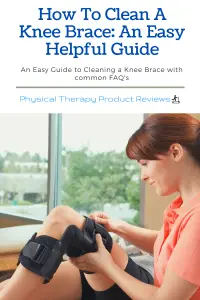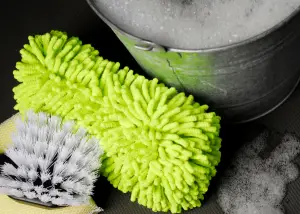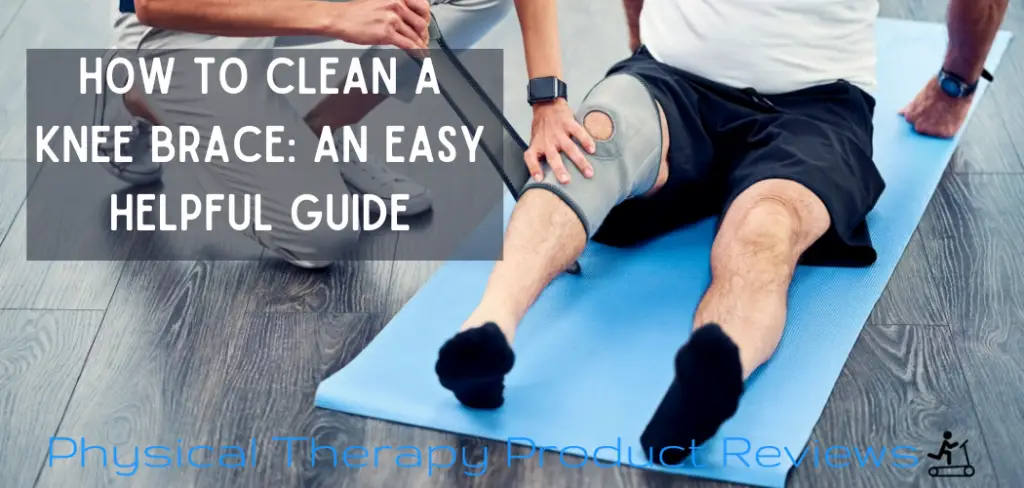If you’re using a knee brace, there’s a good chance that you will be wearing it often since our knees get so much use during a wide range of tasks. As a result, you need to ensure your brace is adequately cleaned and maintained.

You should keep your knee brace clean just as you would keep other items of clothing clean. A dirty knee brace will smell and cause other unpleasant issues like irritation and even bacterial infections.
This guide will give you the tips and information you need on keeping your knee brace clean so it can provide effective, hygienic support for as long as possible.
How to Wash a Neoprene Knee Brace
Neoprene is a stiff, synthetic fabric that can become a breeding ground for odor and bacteria if it isn’t cleaned correctly.
Handwashing a Neoprene Knee Brace
The safest way to wash a neoprene knee brace is to do it the old-fashioned way, by hand.
First, remove any straps or padding from the brace, as you will want to wash these separately to make sure they get a thorough clean.
Follow the steps below to wash your knee brace by hand.
- Fill a bowl or your sink with cool or warm water. Avoid using water that is too hot since it could damage parts of the brace. Make sure you use enough water to submerge your knee brace fully but don’t put the brace in just yet.
- Add a small amount of mild laundry detergent to your water. Read the label on your detergent for an idea of the ratios to use. If you are unsure of the amount, around 5ml should suffice.
In the absence of a proper detergent, you can use a baking soda and vinegar solution instead. Equal parts baking soda and vinegar will clean the brace. - Fully submerge your brace in the water and leave it to soak for around 30 minutes. Half an hour should be enough for the detergent to get to work and loosen the dirt, bacteria, and oils from the neoprene.
If you notice the water getting filthy before the 30 minutes is up, you may wish to replace it with some fresh water and detergent. - Empty the water and refill with fresh, cool water.
- Return the brace to the water and gently move it around to remove the detergent from the neoprene.
- Once you have removed the soap, press as much excess water from the material as you can before leaving to air-dry.
- Once the brace is completely dry, you can wear it as usual.
Machine Washing a Neoprene Knee Brace
To avoid damage, be sure to check the label on your knee brace for specific instructions on cleaning it in a washing machine.
- Remove any metal, plastic, or padded pieces from your knee brace. You can clean these pieces by hand to stop them from getting broken or damaging the machine.
- Put the brace inside your machine and set it to run on a gentle cycle at a cool temperature. Keeping it gentle and cool minimizes the risk of damaging the material.
- Add a mild detergent to your washing machine. Follow the instructions on the detergent bottle as you usually would for a small load of laundry.
- When complete, allow your knee brace to air-dry completely before using it again.
How to Wash a Knee Brace with Hinges
If your knee brace has a hinged mechanism attached, you need to take extra care when cleaning it.
Metal and plastic hinges can be cleaned using the steps outlined above, but they should be removed where possible. Only remove the hinges if they are designed to come off, and you’re sure they will work as intended when you replace them.

Removable hinges can be wiped clean by hand. Always check that metal parts are dried properly to prevent corrosion.
If you can’t remove the hinges and machine wash your brace, make sure you fasten them properly beforehand.
The safest way to wash a knee sleeve with hinges is to use the handwashing steps outlined above.

Washing a Knee Brace with Velcro
If your brace has Velcro straps, the steps to washing it are just the same as those given above. It is best to clean the Velcro by hand and let it air dry.
You can use a small hand brush and soap to get into the hook and loop part of the velcro. This helps get the dirt, hair, and other things that get stuck in the velcro straps.

How to Wash a Nylon Compression Sleeve
Compression sleeves are simple to wash by hand with the same method outlined earlier in this article for neoprene braces.
When washing a compression sleeve, the important thing to remember is to avoid pulling it as you clean it. You don’t want to stretch the sleeve as it needs to maintain a tight fit.
Just as with knee braces, compression sleeves are best left to air dry.
How to wash a Knee Brace with Metal
Metal brace parts should not be placed inside a washing machine. Wiping the metal by hand with a clean cloth and mild soapy water is the best way to clean it.
Whereas material knee braces should be left to air dry, metal ones should be wiped dry with a clean towel.
If metal is left wet, corrosion could occur, so do your best to get any metal parts as dry as you can by hand.
Other ways to dry the metal hinges include using an air compressor to blow out the water inside the hinge joint, using a blow dryer just be sure not to burn yourself as the metal can get hot.
Helpful Tips for Washing a Knee Brace
Don’t Dry it
Except for any metal parts, the best way to get your brace dry is to let it dry naturally in the air. Applying external heat to the material could cause damage, shrinking, or warping.
Don’t leave it in the Sun.
For the same reasons as above, a knee brace shouldn’t be left in direct sunlight for an extended period.
Don’t Use Any Harsh Chemicals.
Not only could such chemicals react with and damage the brace’s material, but they could also irritate your skin.
Most material knee braces have absorbent properties, which means any chemicals used on them could be drawn into the material. When you sweat inside the brace, the substances can be released on your skin and may end up causing irritation.
How to Prevent Odor Build-Up in a Knee Brace
A smelly knee brace isn’t just unpleasant; it also means bacteria are building upon the material. Here are some quick tips for preventing odors from building up on your brace:
- Wipe daily after use with mild soapy water
- Avoid getting your knee brace wet during use
- Try not to get dirt or mud on the brace
- Wear a thin layer beneath your brace to absorb sweat
- Spray your knee brace daily with an anti-bacterial spray
Cleaning a Knee Brace FAQs
How Often Should you Wash Your Knee Brace?
Of course, you should wash your knee brace any time you feel it is dirty or you have sweat inside it considerably.
However, as a rule for general use, you should clean your brace every 4 or 5 days.
Why do knee braces get stinky so quickly?
The material used for manufacturing most knee braces is not very breathable, which means they can make you sweat more, and that sweat has a hard time escaping.
It doesn’t take long before the bacteria inside your sweat starts to smell.
Can You Sleep with a Knee brace on?
A knee brace can be worn while sleeping, and, in some cases, it might be recommended by your healthcare professional. We move around a lot in bed, so some additional knee support could be required.
Conclusion
Cleaning your knee brace is one of the most important ways to make sure that it lasts and that it continues to fit correctly. There are many different types of braces that we covered. Be sure to clean your brace often and let us know in the comments below if you have a different way of cleaning your knee brace.
GLP Weight Loss and Back Health: Effective Strategies and Insights
How to Stay Active After Cervical Fractures: Expert Tips and Advice
Dealing with Painful Stairs After Ankle Replacement Surgery
Walking After a Total Ankle Replacement: Tips for a Successful Recovery
Exercises While Non-Weight Bearing After Ankle Replacement: Elevation, AROM, Leg Raises, and More
Ankle Pain with Stairs: Causes and Home Treatment Options
Disclaimer: The information provided in this post is for educational purposes only. This is not a substitute for a medical appointment. Please refer to your physician before starting any exercise program.






